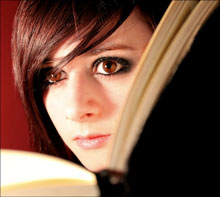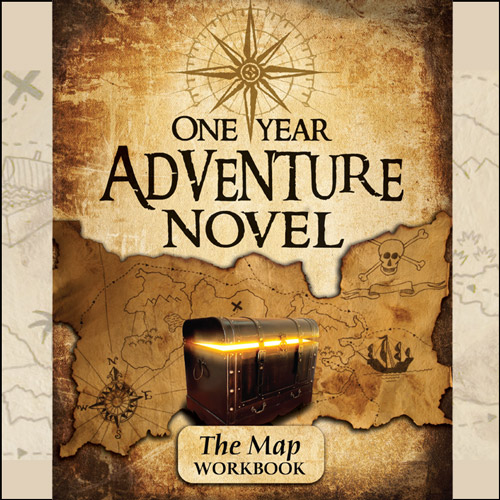How to Write Evil, Awesome Villains
Guest post by Rebecca Harrison
 Deep-set dark eyes. Long, bony fingers rhythmically tapping on a cherrywood desk. Maniacal laughter; a wicked grin; the proclivity for destruction. These are the trademarks of the bad guys. The villains. The antagonists. We hate them, we love them, and sometimes we even feel sorry for them.
Deep-set dark eyes. Long, bony fingers rhythmically tapping on a cherrywood desk. Maniacal laughter; a wicked grin; the proclivity for destruction. These are the trademarks of the bad guys. The villains. The antagonists. We hate them, we love them, and sometimes we even feel sorry for them.
Villains can be some of the most difficult characters to write and they can be the difference between a stagnant story and a powerful one.
Before we get any further, it’s important to understand why villains—good ones, at least—are so important and what purpose they serve in storytelling.
The villain is the catalyst of external conflict, the obstacle standing between your hero and his ultimate goal. He is the opposition of your hero’s positive ideal, or driving nature—the personification of your negative ideal— and he is also responsible for raising the stakes and creating a sense of dread, danger, and suspense. Without a strong villain, many stories fall short or feel hollow—because there isn’t enough conflict or weight to keep the storyline compelling.
But what is it, exactly, that makes a bad guy—well, good?
First of all, a good villain is human. This doesn’t mean he must be a human—there are many great villains who belong to another race or species. However, any character that completely lacks any humanlike qualities tends to feel unbelievable and dull. When a villain is human, he becomes grounded in reality. He becomes a real person—someone with ambitions, desires, fears, hopes, and dreams. He becomes powerful. There are few things as unsettling as facing what atrocities our own race is capable of. We are so intertwined and connected with one another, and we want to perceive ourselves as generally good people. But when that idea is challenged, it draws us to the truth that we all have darkness within us. And that is intimidating.
A good villain is also a threat. He raises the stakes, deepens the risk of destruction should the hero fail. When this is done well, it gives weight to the hero’s decision to take on the story goal and accept his destiny, regardless of what it will cost him. There must be something to fear, to dread, and to sacrifice in order to give that choice power. An intimidating villain creates danger and gives your hero something to overcome.
So how do we go about developing that perfect, multi-dimensional villain?
1. Learn who he is and where he comes from. Mold him just as you would your hero. He is no less important. Figure out what makes him tick, delve into his past and discover his backstory. What makes him feel happy, sad, angry, or alive? Ask yourself what he desires above all else and why. Is it power? Recognition? Even love or acceptance? Is his desire founded on something he suffered in his past? How far will he go to obtain his goal?
2. Make sure that your villain has weakness. In addition to furthering his humanness, giving him at least one noticeable weakness creates instability and the looming threat of potential chaos, should he unravel. Why is this? A villain with no weakness is stable, he is whole. When your readers realize that there are things that can push your villain’s buttons, they will also realize there is a strong chance that he will snap. He will overreact. He will lash out. This leaves your reader worried for what he will do when he is pushed to the edge—and who will be in his wake when that time comes.
Also keep in mind that just like your hero, your villain also faces high stakes. His own goal is threatened by the hero just as the hero’s goal is threatened by him. How does he deal with this threat? Is he intimidated, amused, cautious, or confident? How far will he go to keep himself and his goal out of the hero’s reach?
3. Give him both good and bad qualities. We all have some light and some darkness within us. The founding nature of your villain is that he has allowed the darkness within himself to trample and overtake the good. It’s also a good idea to remember that villains don’t always see themselves as cruel or evil. Just like your hero, he is fighting for something that—within his own eyes—is perfectly justifiable.
4. Base your villain off of yourself. Take one of your own “fatal flaws”—whether it be anger, jealousy, bitterness, or even fear—and give it to your villain…then turn up the volume. This idea often comes across as strange or intimidating; we don’t often like to associate ourselves personally with our antagonists. But by putting yourself into your villain, he becomes even more terrifying because what makes him evil is something real—something that exists within the writer, the reader, and probably even within your hero. When you can relate to your villain on a personal level, you’ll develop a deeper understanding of your villain and build a better foundation for conflict.
5. Examine your own favorite villains—what makes them so great? What drives them, inspires them? What makes them scary, unsettling, or intimidating? Can you relate to them? Make a list of their assets, failures, and ambitions, and then integrate those qualities into your own villain.
Your antagonist is an important part of what drives your story forward. In your villain, you create a pedestal on which to display your hero’s positive qualities. Learning to write evil, awesome villains is a process, but worth your time because it will give your story greater depth, clearer meaning, and make it all the more powerful.
 About Rebecca
About Rebecca
Rebecca Harrison is an aspiring writer and graphic artist who first joined The One Year Adventure Novel in Fall of 2008, where she discovered her passion for storytelling. She is a crazy cat lady in training and while long walks on the beach aren’t her thing, she does enjoy some hot tea and spending quality time reading with her dragon, Spire.



I am especially struck by #4. There are, of course, people who feel uneasy about spending a lot of time developing a villain, and—as you pointed out—are uncomfortable identifying with a villain personally. BUT reading this post, I come away thinking about how this particular act of creation can be a deeply spiritual one—a reckoning with weakness and wrong and a meditation on the “fruit” of a life where our evils are allowed free reign.
Possibly, writers who are thoughtful about this creative process are more sensitive to evil and more committed to exposing it than those who “dutifully” shy away from it.
You’re definitely right, Tineke. This has been my experience when writing many of my villains. It can be very “therapeutic” to face head-on those dark things in yourself and become aware of them so you–like the hero–can fight them. 🙂
My favorite/least favorite villian is the Governor from the Walking Dead! I think he’s so perfect because he really IS a well-rounded character, and he follows all of the villain rules you listed here! Honestly, I kept thinking of him as I was reading this article. 😛
Great article, very helpful!
I still have yet to watch the Walking Dead, but now I want to! Thank you for commenting, I’m glad you found the article helpful. 🙂 Happy writing!
Great article! I am of the opinion that the villain/antagonist (because not all antagonists are necessarily villains) is even more crucial to the story than the hero. In most cases, the hero is likable and “rootable” (the reader wants him to win)…so he has that going for him. However, the story would never happen without a villain. In some ways, he/she must be even more developed than your hero, because he/she has the disadvantage of the reader’s disfavor. I feel like writers in general don’t spend enough time on their villains…I’m so tired of the cheesy cookie-cutter bad guy/girl. I want more Voldemorts, Lokis, and Darth Vaders…bad dudes who were better at everything than their heroes, and yet the heroes met the odds and defeated them anyway.
I’m glad you liked it, Suzanne! You’re totally right. Well-rounded villains take quite a bit more work to create, but it’s always worth it. 🙂 Thanks for reading!
You’re right about the creepiness of the villains. One villain that always got my hair to stand on end was Niska in the Firefly episode “The Train Robbery.” Here was this grandfatherly type guy, smiling, and who had a sense of humor, but who was also participating in the flaying alive of one of his relatives, in a room right behind his office! Wow. And then mentioning that his wife was going to complain about it during dinner, but that “there was no getting away from that”….
I’m breaking out in goosebumps again.
Super great tips! Thank you!
Hey, those are amazing tips! I’ve been working on a series lately, and I totally have to incorperate as many of those awesome villain tips in my villains as possible. I think I like the tip that the villain has to be pretty much human deep down inside. It surprised me, but now that I think about it, it really does make so much sense!
[…] If you want to see how your villain(s) stack up, check out the Better Novel Project’s post about it here and the One Year Adventure Novel’s post on writing good villains here. […]
OOOOHHH YEAH, people love having a good villain to hate,I suggest watching/reading movies/books with welldeveloped villains like Cruella (like all versions of Cruella in every movie) and Lex Luther (Personally I think his sister’s evil backstory makes him look twice as evil)and stuff like the twilightzone has great well developed dread and villains.Don’t copy a villain but do take advice from them, if your a pretty nice person it might be hard for you to create a honest to goodness villainous almost completely evil person with feelings so by watching these people be evil it really helps,I know from experience.